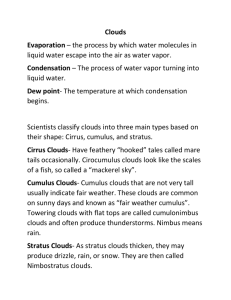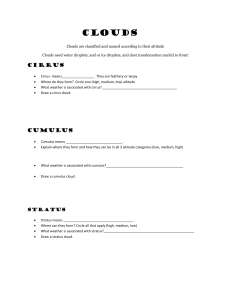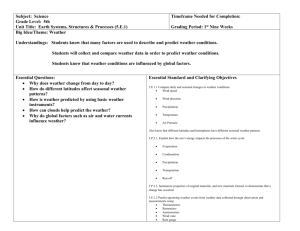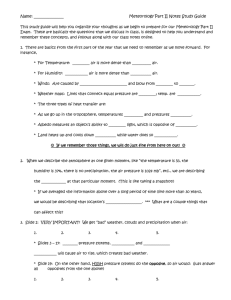Worksheet Ch 23
advertisement
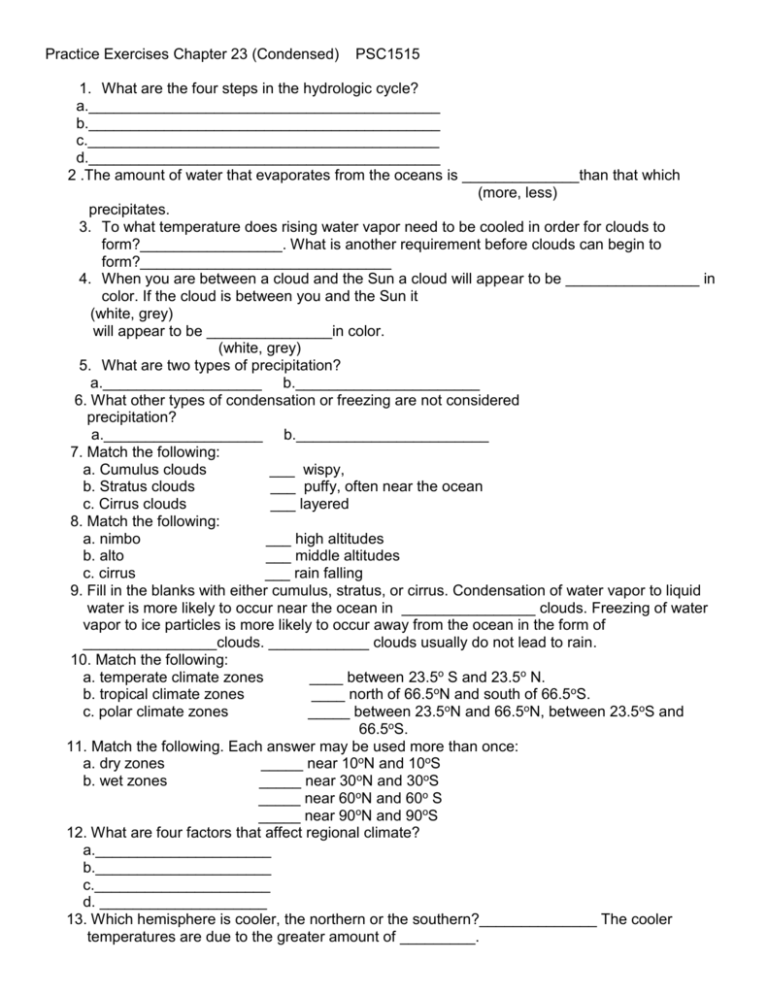
Practice Exercises Chapter 23 (Condensed) PSC1515 1. What are the four steps in the hydrologic cycle? a.__________________________________________ b.__________________________________________ c.__________________________________________ d.__________________________________________ 2 .The amount of water that evaporates from the oceans is ______________than that which (more, less) precipitates. 3. To what temperature does rising water vapor need to be cooled in order for clouds to form?_________________. What is another requirement before clouds can begin to form?______________________________ 4. When you are between a cloud and the Sun a cloud will appear to be ________________ in color. If the cloud is between you and the Sun it (white, grey) will appear to be _______________in color. (white, grey) 5. What are two types of precipitation? a.___________________ b.______________________ 6. What other types of condensation or freezing are not considered precipitation? a.___________________ b._______________________ 7. Match the following: a. Cumulus clouds ___ wispy, b. Stratus clouds ___ puffy, often near the ocean c. Cirrus clouds ___ layered 8. Match the following: a. nimbo ___ high altitudes b. alto ___ middle altitudes c. cirrus ___ rain falling 9. Fill in the blanks with either cumulus, stratus, or cirrus. Condensation of water vapor to liquid water is more likely to occur near the ocean in ________________ clouds. Freezing of water vapor to ice particles is more likely to occur away from the ocean in the form of ________________clouds. ____________ clouds usually do not lead to rain. 10. Match the following: a. temperate climate zones ____ between 23.5o S and 23.5o N. b. tropical climate zones ____ north of 66.5oN and south of 66.5oS. c. polar climate zones _____ between 23.5oN and 66.5oN, between 23.5oS and 66.5oS. 11. Match the following. Each answer may be used more than once: a. dry zones _____ near 10oN and 10oS b. wet zones _____ near 30oN and 30oS _____ near 60oN and 60o S _____ near 90oN and 90oS 12. What are four factors that affect regional climate? a._____________________ b._____________________ c._____________________ d. ____________________ 13. Which hemisphere is cooler, the northern or the southern?______________ The cooler temperatures are due to the greater amount of _________. 14. Which climates have more homogeneous temperature ranges, marine or continental?_______________________. 15. Which are the strongest types weather disturbances which exist with the strongest winds? _____________. 16. Cyclonic storms range from _______________________ to _____________________ to _______________________ depending on the strength of the winds. 17. Match the following types of air masses: ______ warm and humid a. continental polar ______ cold and humid b. maritime polar ______ warm and dry c. continental tropical ______ cold and dry d. maritime tropical 18. Match the type of clouds or weather depending on the fronts: ______ cumulus clouds result a. warm front moving over cold front ______ stratus clouds result b. stationary front ______ atmospheric storms result c. cold front moving over warm front. 19. What does a bulging line on a weather map represent? __________________ Answers: 1. Evaporation of water from the ocean, transport of water vapor in the atmosphere, precipitation over land, runoff from the land to the ocean through rivers and streams. 2. more 3. dew point temperature, condensation nuclei. 4. white, grey 5. rain and snow 6. frost and dew 7. c, a, b 8. c, b, a 9. cumulus, stratus, cirrus 10. b, c, a 11. b, a, b, a 12. altitude, mountains, ocean currents, large bodies of water. 13. southern, water 14. marine 15. tornadoes 16. tropical depressions, tropical storms, hurricanes 17. d, b, c, a 18. c, a, b 19. an air mass moving in


